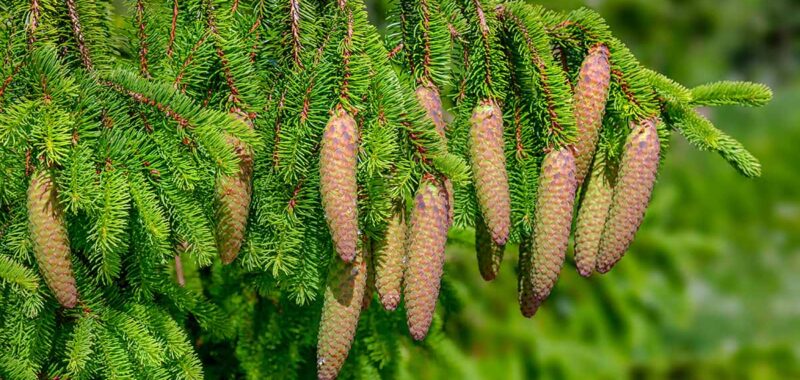Cultivars to Select
These trees naturally hybridize with other spruces, particularly Siberian spruce, and you’ll find lots of hybrid cultivars on the market.


Norway Spruce
If you want to grow the species plant, you can find it available in a variety of sizes at Fast Growing Trees.
The vast majority of cultivars have been bred to be much smaller than the species, so if it’s size you’re going for, stick with the original.
Otherwise, here are a few worthwhile options:
Acrocona
‘Acrocona’ is one of my favorite Norway spruce cultivars.
Not only can the tree tolerate partial shade, but it looks fantastic when the young lime green needles are contrasted against the pinkish-purple cones.
When the cones are mature, they turn tan and the older needles are dark green.


‘Acrocona’
The tree is upright with a drooping shape to the branches. It grows up to 20 feet tall, but it takes years to get there.
If you’d like to grab one for your yard, Maple Ridge Nursery carries ‘Acrocona’ in one- and three-gallon containers.
Bird’s Nest
Bird’s nest (P. abies ‘Nidiformis’) spruce is a popular option as it’s slow growing and will take decades to reach its eventual eight-foot-tall by 12-foot-wide mature size.
The foliage grows in a dense globe-shape with long, gray-green needles. It will eventually develop a small depression in the center, which is why it’s known as “bird’s nest.”


Bird’s Nest
Easygoing with a big impact, this cultivar is definitely an option worth considering. You can find plants available in #1, #1, or #5 containers at Nature Hills Nursery.
Cupressina
If you’re looking for a columnar Norway spruce, ‘Cupressina’ fits the bill. This cultivar matures to 30 feet tall and just six feet wide.
It’s perfect for areas with lots of heavy snow.


‘Cupressina’
While columnar arborvitae might experience broken or bent branches, ‘Cupressina’ will stand strong under the weight of the snow.
You can find this columnar stunner available at Fast Growing Trees.
Gregoryana Parsonii
Many dwarf Norway spruces have mounding or low-growing forms. But ‘Gregoryana Parsonii’ looks like a miniature tree.


‘Gregoryana Parsonii’
It has an irregular pyramidal shape and can grow to about 10 feet tall and eight feet wide at most. It takes years to reach that size, though, and will probably be half that in a decade.
This uncommon option is available at Maple Ridge Nursery.
Little Gem
‘Little Gem’ is just that. It has a mounding shape and stays petite at just three feet wide and two feet tall, though it can grow about twice as large in ideal conditions.


‘Little Gem’
The deep green color and short needles makes it a gem in any rock, Japanese, cottage, or formal garden. It’s a low-maintenance bit of texture and color.
You can find ‘Little Gem’ plants available at Nature Hills Nursery.
Pendula
‘Pendula’ aka weeping spruce is a sight to behold. This variety grows up to 15 feet tall and about the same wide, with long, pendulous branches.


‘Pendula’
You can train it upright for a more weeping form or let it spread wide and low.
You can find weeping spruce available at Fast Growing Trees.
Pumila
‘Pumila’ is a little cutie, often just called dwarf Norway spruce. This cultivar grows up to four feet tall and five feet wide with a beautifully rounded form.


‘Pumila’
It requires no maintenance to keep its petite, compact shape. If you need an accent for a small spot, this one is ideal.
You can find plants available at Nature Hills Nursery.
Maintenance
A mature Norway spruce branch can be a foot or more in diameter. They’re big!
You don’t want to mess with them unless absolutely necessary to remove dead, dying, diseased, or deformed growth.


You can remove young, small branches if you want to provide some shape, especially if you are growing a weeping type or you want to keep yours petite.
Propagation
It’s difficult to start a Norway spruce from seed and it won’t go true if you have collected seeds from a hybrid.
Plus, only cones on trees that are several decades old tend to produce seedlings successfully.


If you want to try growing from seed, we have a guide to propagating pine trees from seed that will cover the entire process.
If you want to reproduce a Norway spruce you love, you can take cuttings.
From Cuttings
Take cuttings from young growth that is still green and pliable, avoiding hard, thick wood.
- In the early to late summer, cut a section about six inches long and strip the needles off the bottom third. Take twice as many cuttings as you need, because not all will take.
- Prepare containers that are four inches or larger and fill them with potting soil.
- Right before planting, re-cut the base of the cutting at an angle and dip the end into powdered rooting hormone.
- Poke a hole in the soil and insert the cutting about an inch deep. Firm the soil around the cutting so it stays upright.
- Set the cutting outside in a spot that receives about six hours of direct light where it will remain for at least a year.
- Keep the soil evenly moist like a well wrung-out sponge but not soggy while you wait for the cutting to root – which can take up to a year.
- That means letting it stay out over the winter months and, hopefully, by the following spring, there will be new growth and roots.
You can give the cutting a gentle tug if you want to be sure roots have developed. Then, transplant into the garden as described below.
Transplanting
To transplant a potted Norway spruce from the nursery or one you started from a cutting, dig a hole that is twice as wide and just a bit deeper than the growing container.

